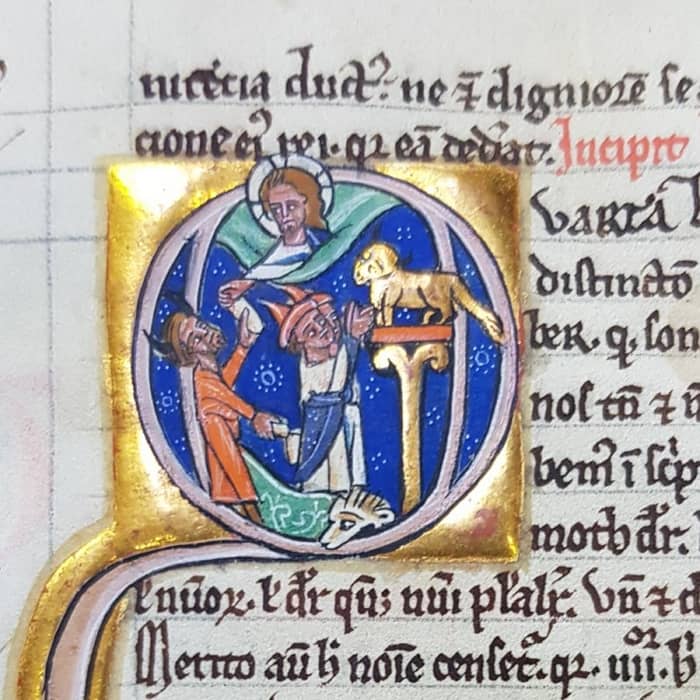
Collection consisting of manuscripts from different periods and themes. The vast majority come from the confiscated funds. The most emblematic piece is the chronicle of Jaume I from 1343, the oldest preserved in Catalan. It also has the 54 extremely valuable codices recovered by Marià Aguiló from the 10th to the 15th centuries, most likely from the cathedral of Girona.
The collection
The collection consisting of approximately 2.180 manuscripts reflecting a variety of periods and subjects. The vast majority comes from confiscated collections, while a small group comes from the former University of Cervera. The ancient cathedral of Girona has also contributed 54 manuscripts, which were purchased in 1857 by Marià Aguiló and are now the oldest and most valuable in the collection. In general, the collection contains medieval manuscripts that date from the 10th to the 14th centuries, with a clear predominance of religious manuscripts, many of which contain beautiful miniatures. Many of the manuscripts feature beautiful miniatures. The oldest manuscript, which dates from the tenth century, contains a commentary on St Matthew by St Jerome and a commentary on St Mark by the Venerable Bede.
The most valuable nucleus corresponds to the manuscripts of the thirteenth and fourteenth centuries, with important pieces for history and Catalan, Spanish and Latin literature. The Crònica del rei Jaume of 1343 stands out, the first version in Catalan preserved.
Regarding the manuscripts from the fifteenth to the nineteenth century, Catalan chronicles and chronicles of religious orders stand out, such as the Annals del convent de Santa Caterina de Barcelona. Special mention must also go to El Livro de Duarte Barbosa of 1524, a description of geography and trade along the coastline of the Indian Ocean, and a celebrated cookbook known as the Book of Sent Soví, accompanied by a treatise on perfume, a treatise on confectionary, and two treatises on veterinary medicine in Catalan by Manuel Dies de Calatayud which are all included in the Miscel·lània catalana: Ms. 68.
The Rare Book and Manuscript CRAI Library houses a small collection of manuscripts in Arabic, Persian, Coptic, Ottoman Turkish and Armenian. You can also find a Chinese grammar, books of sermons in Filipino Tagalog and others in cebuano. And, in Ms. 1808, a glossary and a conversation guide for some indigenous languages in the Guyana area still being spoken in the eighteenth century.
The collection also preserves 59 volumes, often in large format, of catalogues from convent libraries that have come to the University of Barcelona.
Many manuscripts have the added value of containing miniatures, initials, borders and other decorations. More than a hundred are considered to be of major artistic value, including the previously mentioned The Crònica del rei Jaume, several books of hours, a copy of The Rule of St Benedict from the scriptorium of Ripoll, italian humanist manuscripts, bibles, juridical books, etc.
Catalogs and inventories
F. Miquel Rosell. Inventario general de manuscritos de la biblioteca de la Universidad de Barcelona. Madrid: Direcciones Generales de Enseñanza Universitaria y de Archivos y Bibliotecas, 1958-1969.
- Contains descriptions of manuscripts 1 to 2030. PDF version in the University of Barcelona Digital Repositori.
- Inventory of manuscripts 2031 to 2183. PDF version in the University of Barcelona Digital Repository.
Various complementary indexes of the inventory of Miquel Rosell are also available:
- Provisional index of volumes 1-3 of the inventory of F. Miquel Rosell. Miquel Rosell. Ordered by subject and author. Indicates the volume and page number in the inventory. PDF version available in the University of Barcelona Dipòsit Digital of the UB.
- Provisional index of volume 4 of the inventory of F. Miquel Rosell. Divided in two parts: by author and by subject. Indicates the manuscript number in the inventory. PDF version available in the University of Barcelona Dipòsit Digital of the UB.
- Chronological table of manuscripts.
- Table of correspondence between ancient and modern signatures.
Almost 800 manuscripts are listed in the online catalogue, under the category Genre = manuscripts.
Special collections
Former owners

We know the provenance of our books because of handwritten or printed marks of ownership (ex libris, ex donos, stamps, coats of arms, etc.) that are found in them. The former owners are documented and their marks of ownership are digitalized and appear in the database of former owners.
Links of interest
- Online manuscripts in the Biblioteca Patrimonial Digital of the University of Barcelona (BiPaDi)
- Catalogues and bibliographies of manuscripts from the University of Barcelona in the Dipòsit Digital.
- Manuscripts in the Blog de Fons Antic
- Manuscripts in the Sponsor a document project
Participation in external projects



